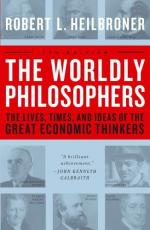|
This section contains 509 words (approx. 2 pages at 400 words per page) |

|
The Worldly Philosophers Summary & Study Guide Description
The Worldly Philosophers Summary & Study Guide includes comprehensive information and analysis to help you understand the book. This study guide contains the following sections:
This detailed literature summary also contains Topics for Discussion and a Free Quiz on The Worldly Philosophers by Robert Heilbroner.
The Worldly Philosophers by Robert L. Heilbroner is a study of the theories of some of the greatest economic thinkers. It is a book that will never go out of date, even if it goes out of print because the theories discussed are still quite relevant. Heilbroner presents some of the most interesting periods in the development of economic philosophical thinking, covering the theories of Adam Smith, Karl Marx, John Stuart Mill, John Maynard Keynes, Joseph Schumpeter, and Thorstein Veblen. Each of these are the subject of their own chapters. David Ricardo and Thomas Malthus are covered together in one chapter. There is a chapter on the Utopian Socialists and another on the Victorian underworld. The book has the subtitle, "The Lives, Times and Ideas of the Great Economic Thinkers." A large part of the chapters are dedicated to the lives of these men and their careers, which Heilbroner makes interesting reading.Heibroner goes further than a text book in that he introduces the readers to their wives and families. All of these men left their mark on the world in some way, even though they were not famous or rulers.
The book begins with the subject of Political Economy since in its early days, economics or political economy was a branch of philosophy. The social and political structures were different then and so was the economy. The economists studied how the system functioned and for many of the early economists, like Adam Smith, economics was a study of the human nature—why men could act in their own best interests and end up doing what was in the best interests of the group.
Heilbroner is not teaching the reader economics. He wrote the book in graduate school, working as a freelance writer to earn some money. He does not delve into economic theory or present the theory of any one economist in detail. The book does cover several of the major points of the theories of each of these economists, but not in detail. Heilbroner provides just enough information so the reader has an idea of what he is talking about and this may be one of the reasons for the popularity of the book. It is very light on economics, which makes the book easy for the reader to understand because he only has to grasp a few economic points for each economist. With Smith, the issue emphasized is the invisible hand, with Ricardo it is rent, with Malthus, it is population growth. The advantage of the book is that the reader can see the development of the field of economics from the way Heilbroner presents the material. Each economist is presented and studied as an individual, even though there is some comparing and contrasting of ideas. Then in the final chapter, Heilbroner considers them as a group with a greater amount of comparing and contrasting.
The book is relatively easy reading as it does not present much economic theory and the theory that it does present is done in everyday English.
Read more from the Study Guide
|
This section contains 509 words (approx. 2 pages at 400 words per page) |

|



